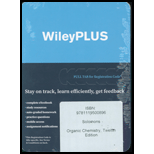
Interpretation:
The reason for the statement “The mass spectrum of 3-methylpentane has a peak of very low relative abundance at
Concept introduction:
Mass spectrometry involves formation of ions in a mass spectrometer followed by separation and detection of the ions according to mass and charge.
The mass spectrum is a graph with mass (
One of the highest value m/z may or may not represent the molecular ion, that is, the ion with the formula weight of the original compound. When present, the molecular ion is usually not the base peak because the ions from the original compound molecule tend to fragment, thereby resulting in the other m/z peaks in the spectrum.
Small peaks having m/z values 1 or 2 higher than the formula weight of the compound are because of 13C and other isotopes.
Molecular ions formed by EI mass spectrometry are high-energy species and these are called radical cations because it contains both an unshared electron and a positive charge. Fragmentation of molecular ion means that a complex molecule is broken into smaller molecules and these fragments can undergo more breaking and so on.
Cleavage of a single bond produces a cation and a radical. The cation can be detected using positive ion mass spectrometry and because the radical is not charged, it will be undetected.
Chain branching or cleavage of a single bond at branch points will occur such that the carbocation formed is more stable. In simple words, the stability of carbocation determines the fragmentation pattern.
Want to see the full answer?
Check out a sample textbook solution
Chapter 9 Solutions
ORGANIC CHEMISTRY-WILEYPLUS ACCESS PKG.
- Identify as SN1 or SN2 and write the mechanism.arrow_forwardComplete the reaction. Not the mechanism.arrow_forwardDraw the mechanism using the arrows on conventions, including all formal charges and correct arrows. If stereochemical distinction can be made they should be included in the structure of the products.arrow_forward
- Draw the epoxide formed when the following alkene is treated with mCPBA. Click the "draw structure" button to launch the drawing utility. draw structure ...arrow_forwardRank each of the following substituted benzene molecules in order of which will react fastest (1) to slowest (4) by electrophilic aromatic substitution. Explanation Check CF3 (Choose one) OH (Choose one) H (Choose one) (Choose one) © 2025 McGraw Hill LLC. All Rights Reserved. Terms of Use | Privacyarrow_forwardIdentifying electron-donating and electron-withdrawing effects For each of the substituted benzene molecules below, determine the inductive and resonance effects the substituent will have on the benzene ring, as well as the overall electron-density of the ring compared to unsubstituted benzene. Molecule Inductive Effects Resonance Effects Overall Electron-Density CF3 O donating O donating O electron-rich O withdrawing withdrawing O no inductive effects O no resonance effects O electron-deficient O similar to benzene OCH3 Explanation Check O donating O donating ○ withdrawing withdrawing O no inductive effects no resonance effects electron-rich electron-deficient O similar to benzene Х © 2025 McGraw Hill LLC. All Rights Reserved. Terms of Use | Privacy Centerarrow_forward
- The acid-base chemistry of both EDTA and EBT are important to ensuring that the reactions proceed as desired, thus the pH is controlled using a buffer. What percent of the EBT indicator will be in the desired HIn2- state at pH = 10.5. pKa1 = 6.2 and pKa2 = 11.6 of EBTarrow_forwardCUE COLUMN NOTES (A. Determine Stereoisomers it has ⑤ Identify any meso B compounds cl Br cl -c-c-c-c-¿- 1 CI C- | 2,4-Dichloro-3-bromopentanearrow_forwardThe acid-base chemistry of both EDTA and EBT are important to ensuring that the reactions proceed as desired, thus the pH is controlled using a buffer. What percent of the EBT indicator will be in the desired HIn2- state at pH = 10.5. pKa1 = 6.2 and pKa2 = 11.6 of EBTarrow_forward
 Organic ChemistryChemistryISBN:9781305580350Author:William H. Brown, Brent L. Iverson, Eric Anslyn, Christopher S. FootePublisher:Cengage Learning
Organic ChemistryChemistryISBN:9781305580350Author:William H. Brown, Brent L. Iverson, Eric Anslyn, Christopher S. FootePublisher:Cengage Learning
 Organic Chemistry: A Guided InquiryChemistryISBN:9780618974122Author:Andrei StraumanisPublisher:Cengage Learning
Organic Chemistry: A Guided InquiryChemistryISBN:9780618974122Author:Andrei StraumanisPublisher:Cengage Learning


